Borehole Logging and Slug Tests for Evaluating the Applicability of Electrical Resistivity Tomography for Groundwater Exploration in Nampula Complex, Mozambique
Abstract
:1. Introduction
- i.
- Estimate the thickness of the productive zone
- ii.
- Identify possible fractures that were not detected by ERT
- iii.
- Correlate ERT models with hydraulic properties of the aquifer.
2. The Study Area
3. Methodology
3.1. Selection of the Investigated Boreholes
3.2. Electrical Resistivity Tomography
3.3. Borehole Geophysical Logging
3.4. Slug Test
3.5. Additional Information
4. Results
4.1. Electrical Resistivity Tomography
4.2. Geophysical Logging
4.3. Slug Test
5. Discussion
6. Conclusions
Acknowledgments
Author Contributions
Conflicts of Interest
References
- MacDonald, A.; Calow, R. Developing groundwater for secure rural water supplies in Africa. Desalination 2009, 248, 546–556. [Google Scholar] [CrossRef]
- Wright, E.P.; Burgess, W. The hydrogeology of crystalline basement aquifers in Africa. Geol. Soc. Spec. Publ. 1992, 66, 1–27. [Google Scholar] [CrossRef]
- Salomon. Design Report No. 1 for 150 Water Points—Cabo Delgado and Nampula Rural Water Point Installation Program Mozambique; Cowater International Inc. and Salomon Lda: Maputo, Mozambique, 2010; p. 181. [Google Scholar]
- Chirindja, F.; Dahlin, T.; Juizo, D. Improving groundwater well sitting approach in consolidated rock in Nampula province, Mozambique. Hydrogeology 2016, in press. [Google Scholar]
- Chirindja, F.; Dahlin, T.; Juizo, D.; Stainbrunch, F. Reconstructing the formation of a coastal aquifer in Nampula province, Mozambique from ERT and IP methods for water prospection. Environ. Earth Sci. J. 2017, 76. [Google Scholar] [CrossRef]
- Darling, T. Well Logging and Formation Evaluation; Elsevier: Burlington, MA, USA, 2005; p. 335. [Google Scholar]
- McElwee, C. Improving the analysis of slug tests. J. Hydrol. 2002, 269, 122–133. [Google Scholar] [CrossRef]
- George, R.J. Hydraulic properties of groundwater systems in the saprolite and sediments of the wheatbelt, Western Australia. J. Hydrol. 1992, 130, 251–278. [Google Scholar] [CrossRef]
- Vermeulen, P.; van Tonder, G. Slug Tests in Fractured Rock Formations: Value, Pitfalls and Misinterpretations. In Water Resources of Arid Areas, Proceedings of the International Conference on Water Resources of Arid and Semi-Arid Regions of Africa, Gaborone, Botswana, 3–6 August 2004; Taylor & Francis: London, UK; p. 21.
- Geologia, D.N.D. Base de Dados do Mapa Geológica de Mocambique Escala 1:1000,000 (Data Base of Mozambique Geological Map); National Directorate of Mines: Maputo, Mozambique, 1989; p. 350.
- Geoscience, C.F. Map Explanation: Sheets 1537 Alto Molócuè, 1538 Murrupula, 1539 Nampula, 1540 Mogincual, 1637 Errego, 1638 Gilé and 1639–40 Angoche; Mozambique and Council for Geoscience: Pretoria, South Africa, 2007. [Google Scholar]
- Lächelt, R. Geology and Mineral Resources of Mozambique; National Directorate of Mines: Maputo, Mozambique, 2004.
- Kumar, D.; Mondal, S.; Nandan, M.; Harini, P.; Sekhar, B.S.; Sen, M.K. Two-dimensional electrical resistivity tomography (ERT) and time-domain-induced polarization (TDIP) study in hard rock for groundwater investigation: A case study at Choutuppal Telangana, India. Arab. J. Geosci. 2016, 9, 1–15. [Google Scholar] [CrossRef]
- Ferro, B.; Bouman, D. Explanatory Notes of the Hydrogeological Map of Mozambique, Scale 1:1,000,000. Project of the Hydrogeological Map of Mozambique; National Directorate of Water Affairs: Maputo, Mozambique, 1987.
- Dahlin, T.; Zhou, B. Multiple-gradient array measurements for multichannel 2d resistivity imaging. Near Surf. Geophys. 2006, 4, 113–123. [Google Scholar] [CrossRef]
- Loke, M.H.; Acworth, I.; Dahlin, T. A comparison of smooth and blocky inversion methods in 2d electrical imaging surveys. Explor. Geophys. 2003, 34, 182–187. [Google Scholar] [CrossRef]
- Limited, R.G. Winlogger Software. Available online: http://www.webcitation.org/query?url=http%3A%2F%2Fwww.geologging.com%2Fslimhole-logging%2Fwinlogger-software%2F+&date=2016–12–07 (accessed on 30 September 2016).
- Olsson, E. Water Well Investigation in Nampula Province—A Minor Field Study. Master’s Thesis, Lund University, Lund, Sweden, March 2016. [Google Scholar]
- Acworth, I. The electrical image method compared with resistivity sounding and electromagnetic profiling for investigation in areas of complex geology: A case study from groundwater investigation in a weathered crystalline rock environment. Explor. Geophys. 2001, 32, 119–128. [Google Scholar] [CrossRef]
- Todd, D.; Mays, L. Grounwater Hydrology; John Wiley & Sons: San Francisco, CA, USA, 2005. [Google Scholar]
- Butler, J.J., Jr. The Design, Performance, and Analysis of Slug Tests; CRC Press: Boca Raton, FL, USA, 1997. [Google Scholar]
- Hallerbäck, S. Water Well Investigation in Nampula Province—Slug Tests in Weathered Crystalline Rock—A Minor Field Study. Bachelor’s Thesis, Lund University, Lund, Sweden, March 2016. [Google Scholar]
- Bouwer, H.; Rice, R. A slug test for determining hydraulic conductivity of unconfined aquifers with completely or partially penetrating wells. Water Resour. Res. 1976, 12, 423–428. [Google Scholar] [CrossRef]
- Cooper, H.H.; Bredehoeft, J.D.; Papadopulos, I.S. Response of a finite-diameter well to an instantaneous charge of water. Water Resour. Res. 1967, 3, 263–269. [Google Scholar] [CrossRef]
- Barker, J.A.; Black, J.H. Slug tests in fissured aquifers. Water Resour. Res. 1983, 19, 1558–1564. [Google Scholar] [CrossRef]
- Shedlock, S. Borehole Geophysical Logging in Masvingo Province, Zimbabwe; British Geological Survey: Nottingham, UK, 1987; 44p. [Google Scholar]
- Gundersen, L.C.; Wanty, R.B. Field Studies of Radon in Rocks, Soils, and Water; Geological Survey: Alexandria, VA, USA, 1991.
- Domenico, P.A.; Schwartz, F.W. Physical and Chemical Hydrogeology; Wiley: New York, NY, USA, 1998; Volume 506. [Google Scholar]
- Sharp, J.M. Fractured Rock Hydrogeology; Taylor & Francis: London, UK, 2014. [Google Scholar]
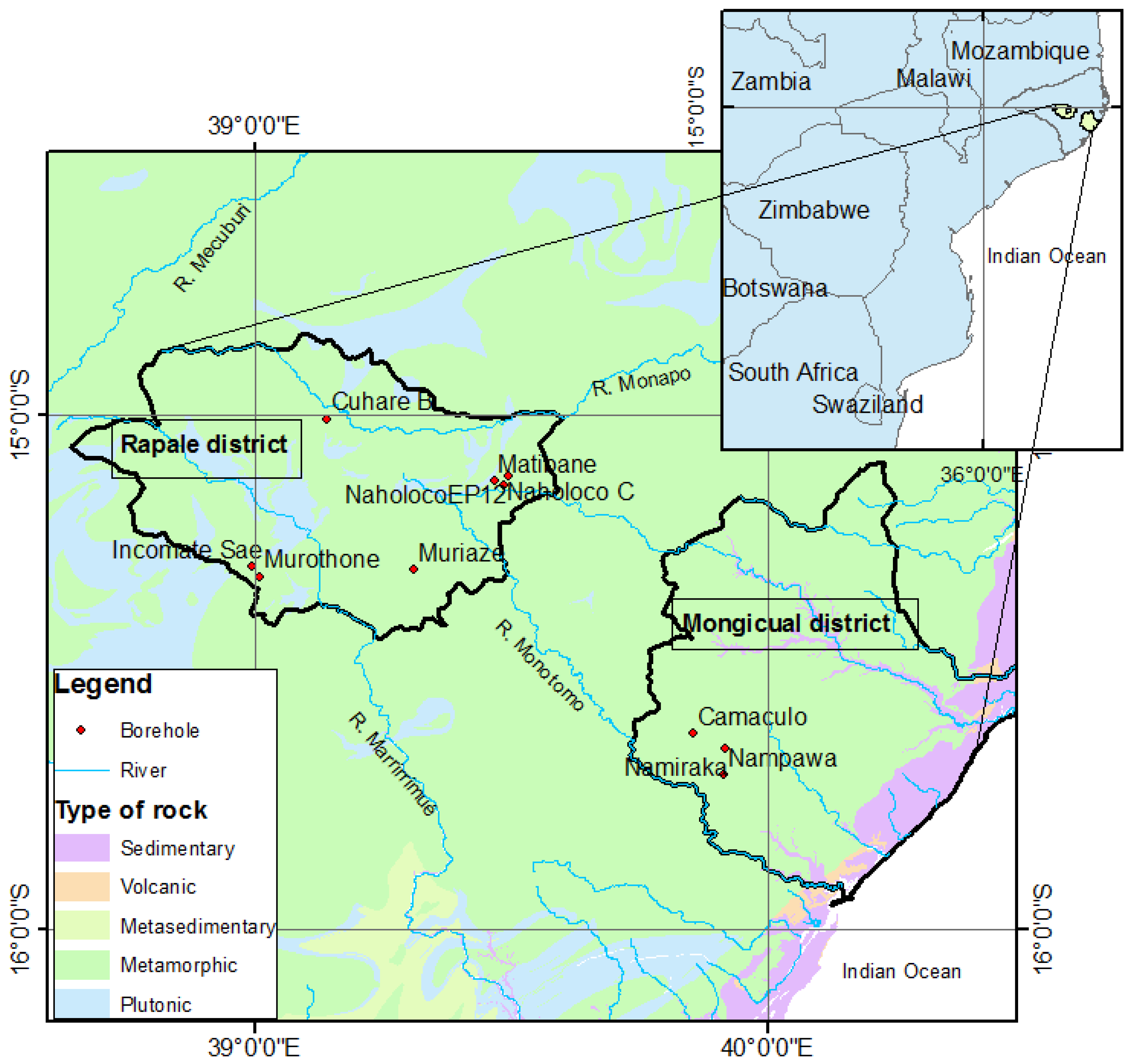


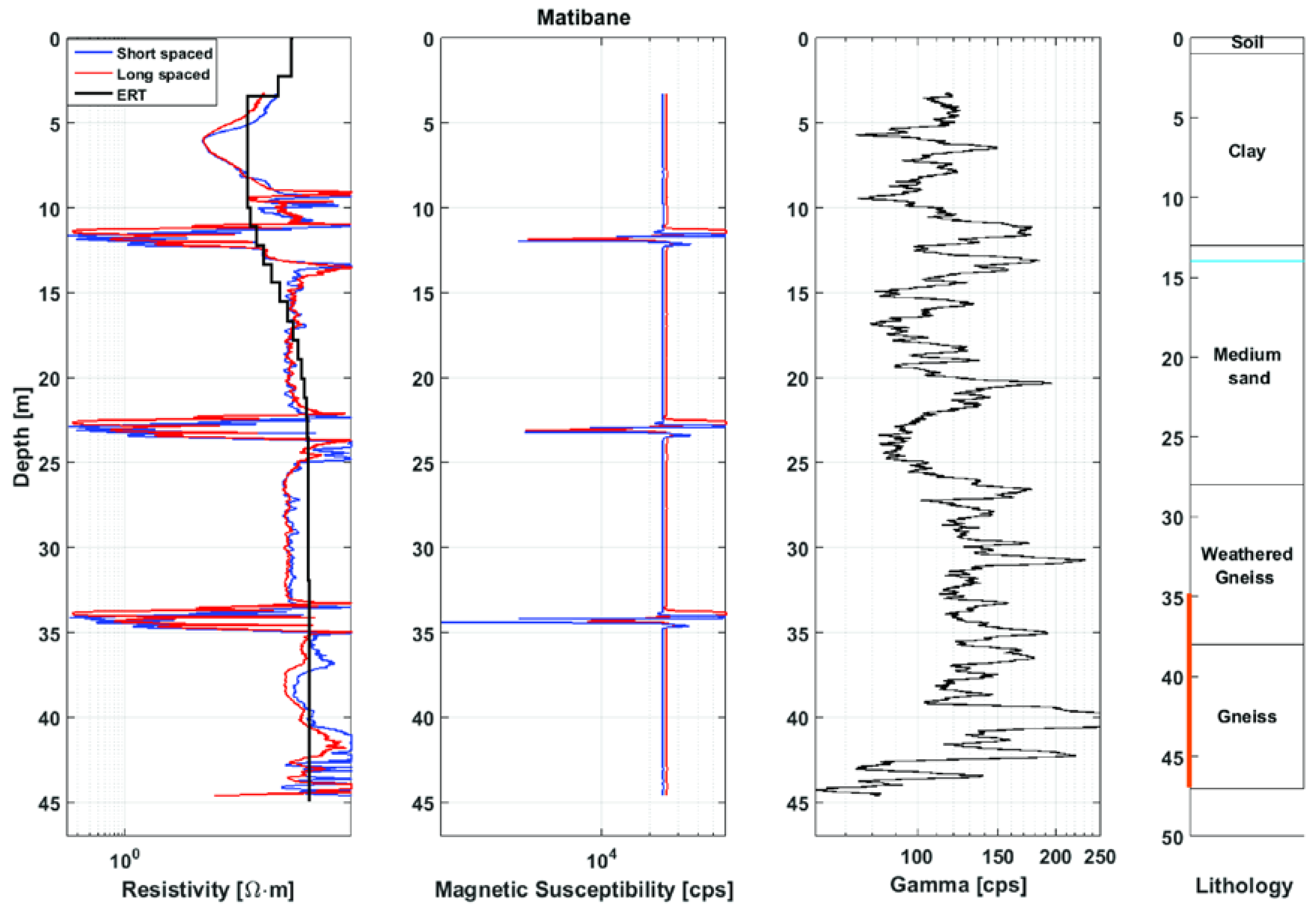
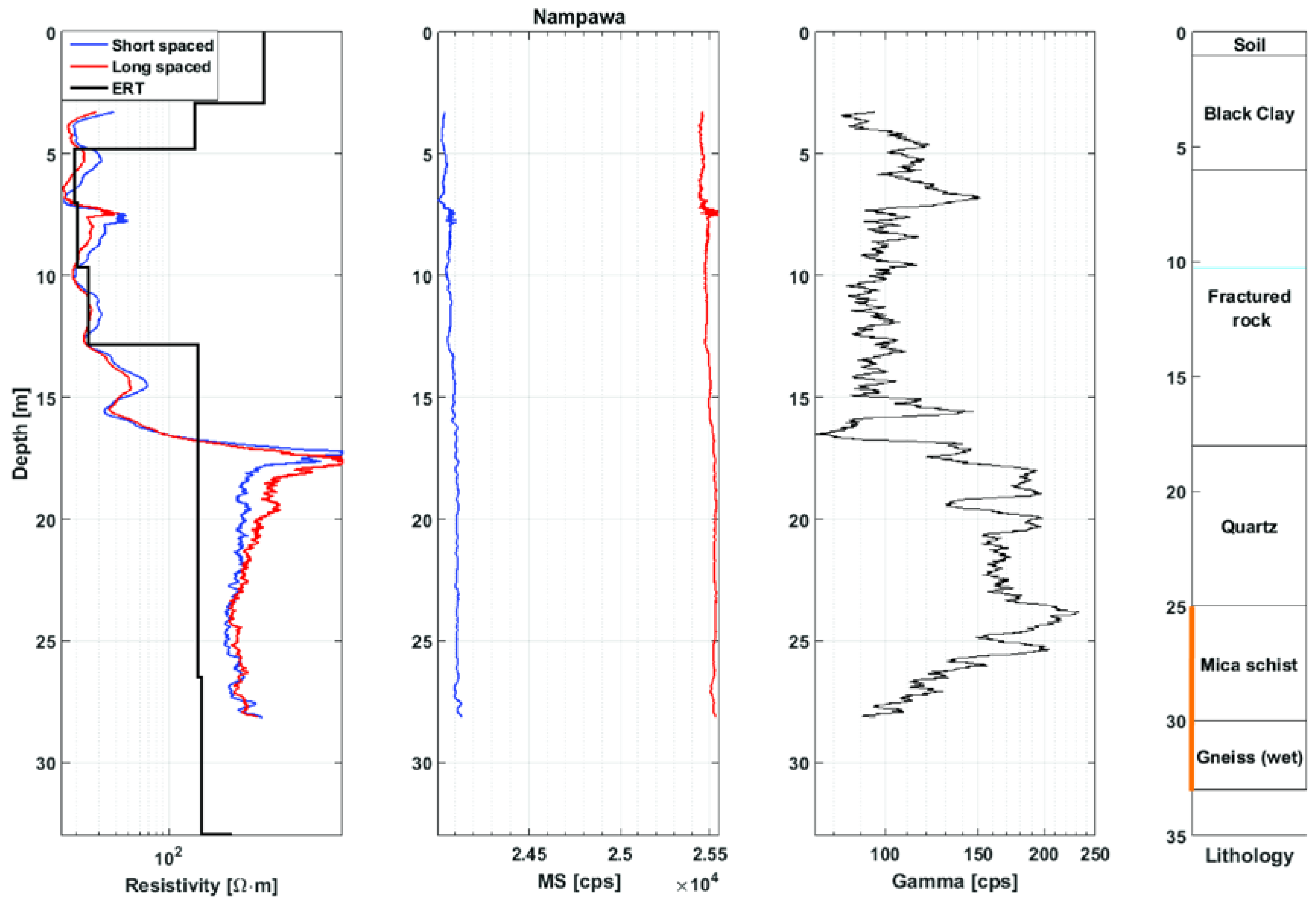
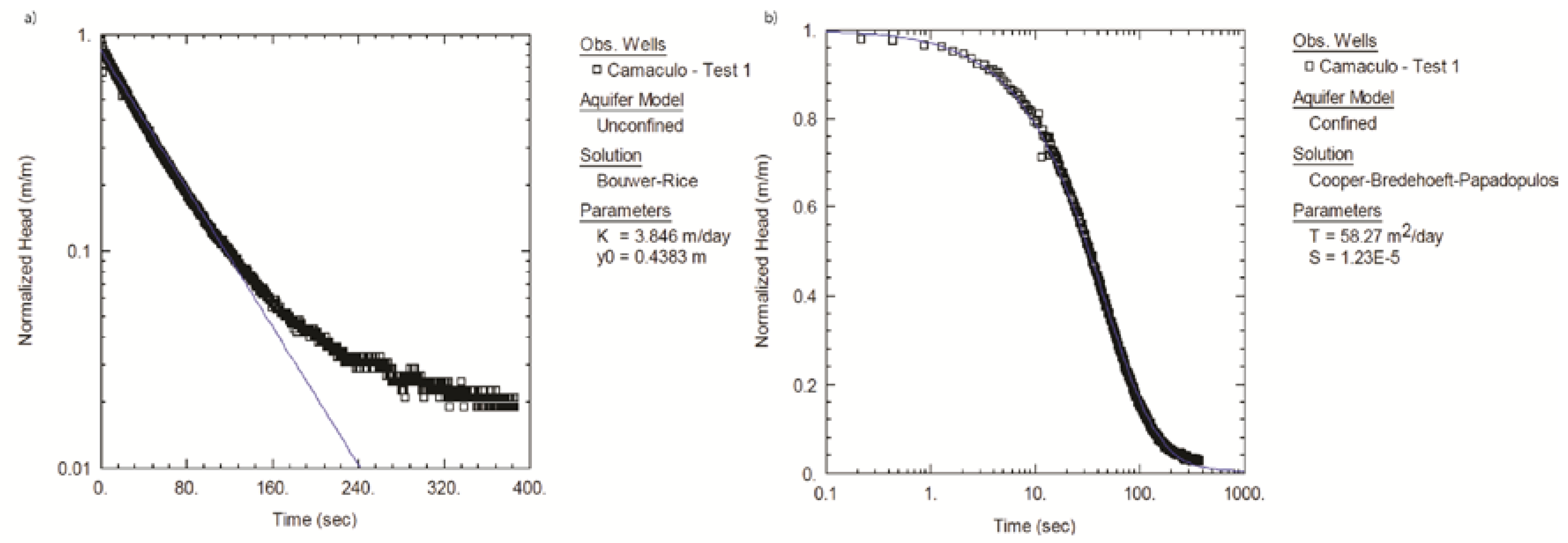
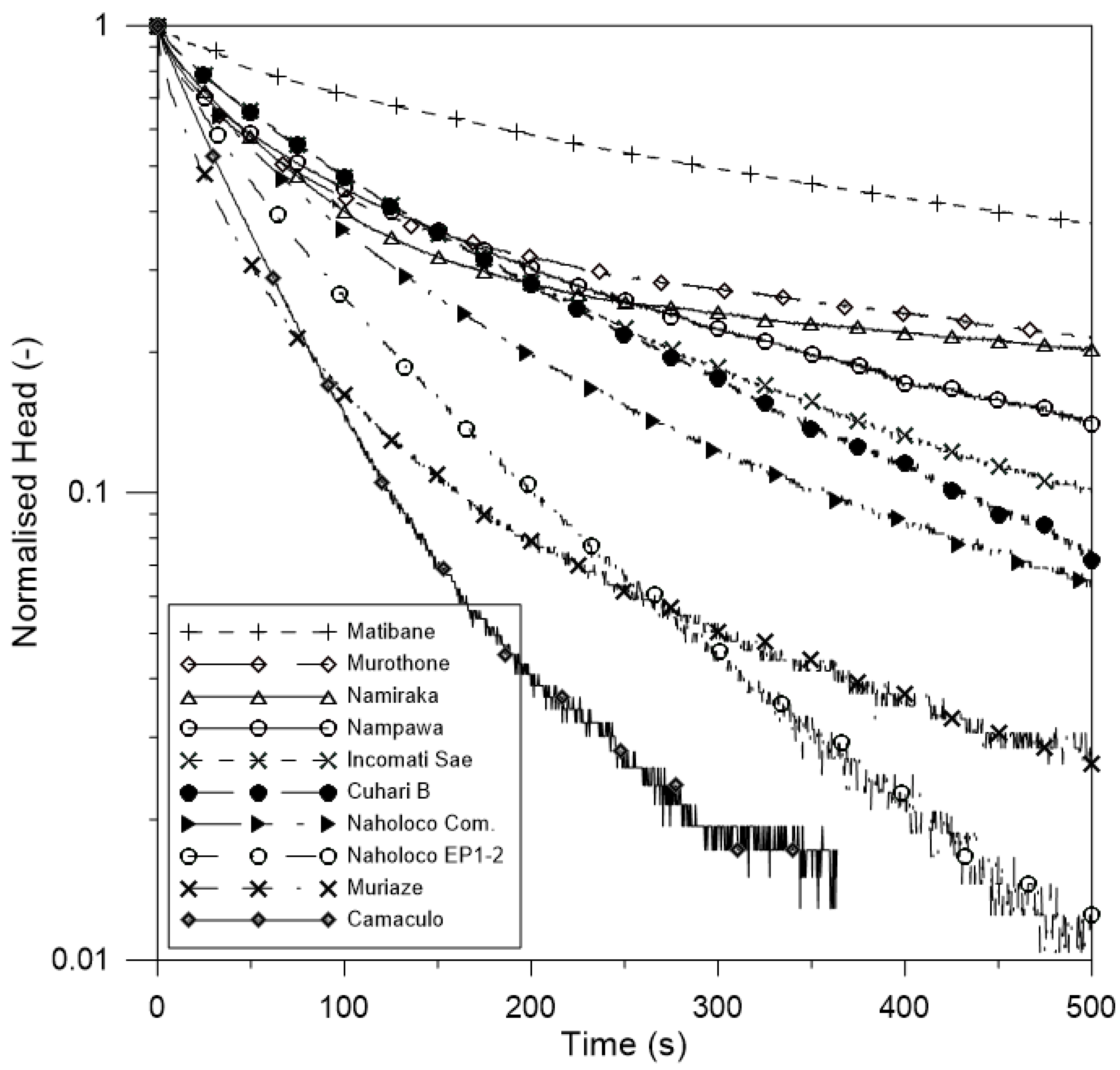

| Soil | Description of Typical Lithology | Resistivity (Ωm) |
|---|---|---|
| Soil ‘A’ | Generally less than 0.5 m thick. Generally red sandy soil, high porosity, well drained and leached. Laterite seldom present in areas of active erosion | 160–200 (wet) 2000–4000 (dry) |
| Soil ‘a’ | Few meters thick sand and clay or clay sand, often concretionary | 100–200 |
| Soil ‘b’ | Massive accumulation of secondary minerals (clay) in which some stable primary minerals remain. Low permeability and high porosity. Usually damp but yields little water. | 10–90 |
| Soil ‘c’ | 1 to 30 m thick. Rock which is progressively altered upward to a granular friable layer of disintegrated crystal aggregates and rock fragments. Intermediate porosity and permeability. This zone frequently contains sub-artesian water, confined by upper clay rich material. | 60–300 |
| Soil ‘d’ | 1 to 20 m thick. Fractured and fissured rock. Low porosity but moderate to high permeability in fissures. | 300–600 |
| Fresh rock | Unweathered migmatite and granite | 2000–6000 |
| Borehole | Layer 1 (m) | Layer 2 (m) | Layer 3 (m) | Basement (m) | Depth (m) | Specific Capacity (m2/day) [22] |
|---|---|---|---|---|---|---|
| Cuhare B | 5 | 15 | 5 | 4 | 34 | 2.67 |
| Incomate | 7 | 20 | 11 | 0 | 38 | 2.27 |
| Matibane | 12 | 9 | 0 | 26 | 47 | 0.60 |
| Muriaze | 10 | 18 | 9 | 0 | 37 | 2.21 |
| Murothone | 0 | 10 | 0 | 28 | 38 | 1.05 |
| Naholoco C | 5 | 25 | 8 | 0 | 38 | 1.14 |
| Naholoco EP1 | 2 | 5 | 20 | 18 | 45 | 3.33 |
| Camaculo | 5 | 25 | 15 | 0 | 45 | 3.57 |
| Namiraca | 3 | 10 | 2 | 28 | 43 | 0.83 |
| Nampawa | 0 | 15 | 18 | 0 | 33 | 1.71 |
© 2017 by the authors. Licensee MDPI, Basel, Switzerland. This article is an open access article distributed under the terms and conditions of the Creative Commons Attribution (CC BY) license (http://creativecommons.org/licenses/by/4.0/).
Share and Cite
Chirindja, F.; Rosberg, J.-E.; Dahlin, T. Borehole Logging and Slug Tests for Evaluating the Applicability of Electrical Resistivity Tomography for Groundwater Exploration in Nampula Complex, Mozambique. Water 2017, 9, 95. https://doi.org/10.3390/w9020095
Chirindja F, Rosberg J-E, Dahlin T. Borehole Logging and Slug Tests for Evaluating the Applicability of Electrical Resistivity Tomography for Groundwater Exploration in Nampula Complex, Mozambique. Water. 2017; 9(2):95. https://doi.org/10.3390/w9020095
Chicago/Turabian StyleChirindja, Farisse, Jan-Erik Rosberg, and Torleif Dahlin. 2017. "Borehole Logging and Slug Tests for Evaluating the Applicability of Electrical Resistivity Tomography for Groundwater Exploration in Nampula Complex, Mozambique" Water 9, no. 2: 95. https://doi.org/10.3390/w9020095






